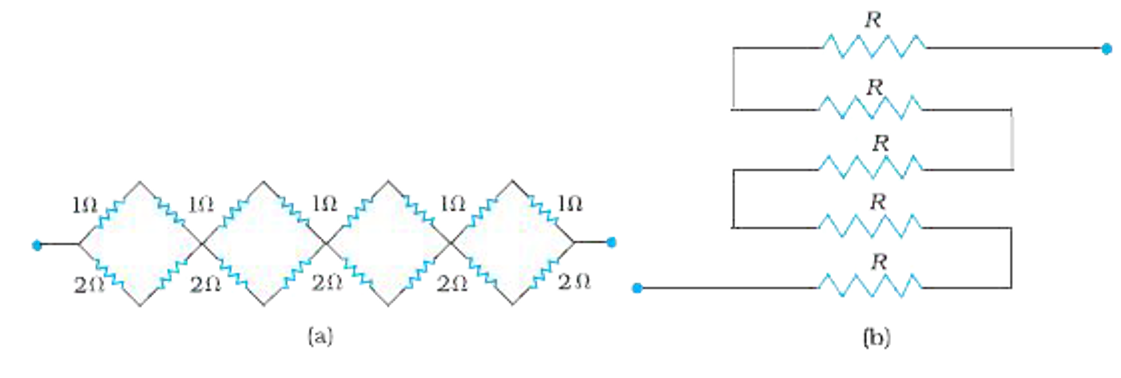Complete Solutions to ADDITIONAL EXERCISES of chapter CURRENT ELECTRICITY of Class 12 book with complete answers and questions
| Class 12 | PHYSICS |
| Chapter | CURRENT ELECTRICITY |
| NCERT TAMIL | ADDITIONAL EXERCISES |
| Number Of Questions | 9 |
| Academic Year | 2023-24 |
The earth's surface has a negative surface charge density of `10^(-9) Cm^(-2)` . The potential difference of 400 kV between the top of the atmosphere and the surface results (due to low conductivity of the lower atmosphere) in a current of only 1800 A over the entire globe. If there were no mechanism of sustaining atmosphereic electric field , how much time (roughly) would be required to neutralise the earth's surface ? (This never happens in practice because there is a mechanism to replenish electric charges namely the continual thunder storms and lightning in different parts of the globe). Radius of the earth `= 6.37 xx 10^(6) m`.
03:31View SolutionSix lead-acid type of secondary cells each of emf `2.0` V and internal resistance `0.015Omega` are jouned in series to provide a supply to a resistance of `8.5Omega`. What are the current drawn from the supply and its terminal voltage ?
(b) A secondary cells after long use has an emf of `1-9` V and a large internal resistance of `380 Omega`. What maximum current can be drawn from the cell ? Could the cell drive the starting motor of a car ?05:20View SolutionTwo wires of equal length, one of aluminium and the other of copper have the same resistance. Which of the two wires is lighter ? Hence explain why aluminium wires are perferred for overhead power cables. Given For `AI. p_(1)=2.63xx10^(-8)Omega m`, For `Cu, p_(2)=1.72xx10^(-8)Omega m`. Relative density of `AI =2.7` of `Cu =8.9`.
04:07View SolutionWhat conclusion can you draw from the follwing observation on a resistor made of alloy manganin ? `
 `
02:50View Solution
`
02:50View SolutionAnswer the following questions : (a) A steady current flows in a metallic conductor of non-uniform cross-section. Explain which of these quantities is constant along the conductor : current, current density, electric field and drift speed ?
(b) Is Ohm's law universally applicable for all conducting elements ? If not, give examples of elements which do not obey Ohm's law.
(c) A low voltage supply from which one needs high currents must have low internal resistance, why ?
(d) A high tension `(HT)` supply of say `6 kV` must have a very large internal resistance. why ?04:32View SolutionChoose the correct alternatives :
(a) Alloys of metals usually have (greater/less) resistivity than that of their constituent metals.
(b) Alloys usually have much (lower/higher) temperature coefficients of resistance than pure metals.
(c ) The resistivity of the alloy manganin in (nearly independent of/ increase rapidly ) with increase of temperature.
(d) The resistivity of a typical insulator (e.g. amber) is greater than that of a metal by a factor of the order of `(10^(22) or 10^(3))`.04:56View Solution(a) Given n resistores each of resistance R. how will you combine them to get the (i) maximum (ii) minimum effective resistance?
(b) Given the resistances of `1 Omega, 2 Omega, 3 Omega.` how will be combine them to get an equivalent resistance of `(i) (11//3) Omega (ii) (11//5) Omega, (iii) 6 Omega, (iv) (6//11) Omega` ?
(c ) Determine the equivalent resistance of networks shown in
 11:20View Solution
11:20View SolutionDetermine the furrent drawn from a 12 V suly with internal resistacne `0.5Omega ` by the infinite network shown in Each rsistor has `1Omega` resistance.
 05:42View Solution
05:42View Solutionshow a `2.0V` potentiometer used for the determination of internal resistance of a `1.5V` cell. The balance point of the cell in open circuit is `76.3` cm. When a resistor of `9.5Omega` is used in the external circuit of the cell, the balance point shifts to `64.8 cm` length of the potentiometer wire. Determine the internal resistance of the cell.
 03:31View Solution
03:31View Solution
ADDITIONAL EXERCISES questions and complete solutions for chapter CURRENT ELECTRICITY of FULL MARKS PHYSICS(TAMIL) of Class 12
